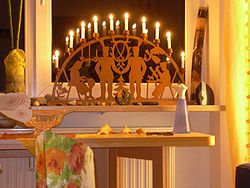
Schwibbogen
Encyclopedia

Saxony
The Free State of Saxony is a landlocked state of Germany, contingent with Brandenburg, Saxony Anhalt, Thuringia, Bavaria, the Czech Republic and Poland. It is the tenth-largest German state in area, with of Germany's sixteen states....
, Germany
Germany
Germany , officially the Federal Republic of Germany , is a federal parliamentary republic in Europe. The country consists of 16 states while the capital and largest city is Berlin. Germany covers an area of 357,021 km2 and has a largely temperate seasonal climate...
.
The first metal Schwibbogen was made in 1740 in Johanngeorgenstadt
Johanngeorgenstadt
Johanngeorgenstadt is a mining town in Saxony’s Ore Mountains, 17 km south of Aue, and 27 km northwest of Karlovy Vary. It lies in the district of Erzgebirgskreis, and right on the border with the Czech Republic, is a state-recognized health resort , and calls itself Stadt des...
. The early candle arches always consisted of black ore. They were made out of one single forged piece and could be painted. The number of candles varies with the size of the arc. The original one featured 11.
The most famous design was created by Paula Jordan in 1937 for a show in Schwarzenberg
Schwarzenberg
- People :* House of Schwarzenberg, Frankish and Bohemian aristocratic family which was first mentioned in 1172** Karl Philipp, Prince of Schwarzenberg , Field Marshal in Austrian service during the Napoleonic Wars...
. It depicted the 3 main sources of income of the people in the region in the 18th and 19th century. Thus the Schwibbogen showed apart from some traditional symbols; 2 miners, 1 wood carver, a bobbin lace maker, a Christmas Tree, 2 miner's hammers, 2 crossed swords, and an angel. It holds 7 candles. Contrary to popular belief the candle holder was always associated with Christmas. The light symbolizes the longing of the miners who didn't see the daylight in winter for weeks sometimes due to their long working hours below the surface.
Over time the designs changed. Especially in the last few decades after the World War II
World War II
World War II, or the Second World War , was a global conflict lasting from 1939 to 1945, involving most of the world's nations—including all of the great powers—eventually forming two opposing military alliances: the Allies and the Axis...
the Schwibbogen has reached not only a new popularity, but has changed a lot in its looks. Now it is typically made out of wood which depicts historical or religious scenes. But there are even landscapes, skylines, advertisements ... there is almost no limit to the possibilities. What remains is the link to Christmas traditions. Especially in the Ore Mountains the windows of the houses in villages and towns feature a lit candle arch - usually with the traditional designs or at least local scenes.
The town of Seiffen
Seiffen
The town of Seiffen is located in the district of Erzgebirgskreis, which is the south-center of the Free State of Saxony in Germany. The earliest record of the town is from 1324 when it was referred to as "Cynsifen"....
is particularly noted for its production of Schwibbogen in its craft shops.

